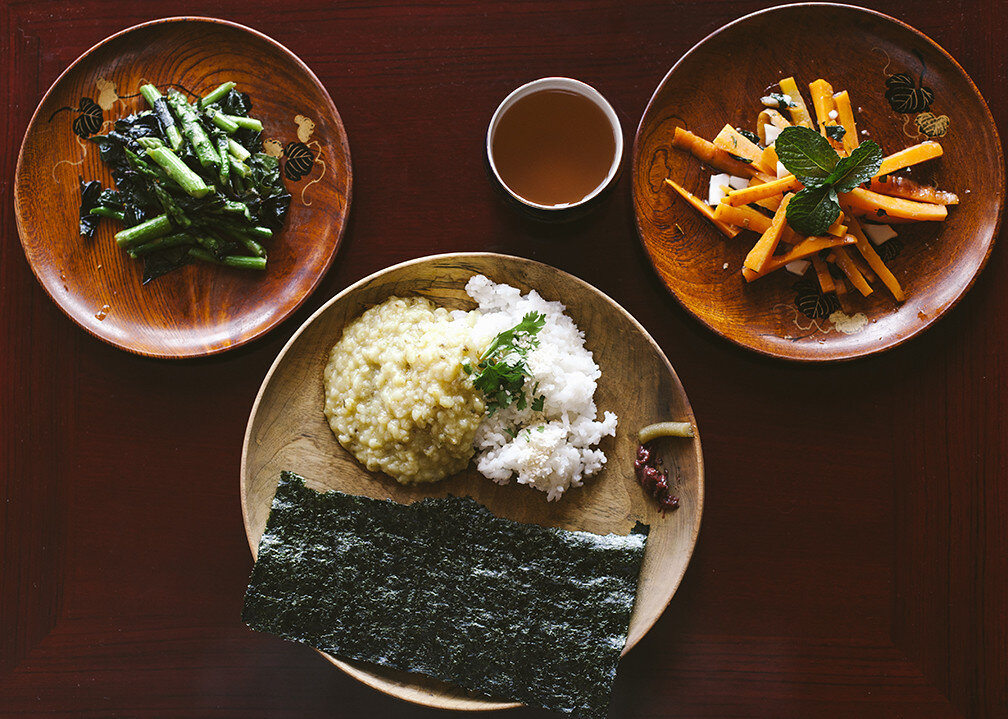
Growing asparagus is a practice in faith.
Two years ago, we planted 2,000 asparagus plants on our own Durga Farms, where Hale Pule gets the freshest veggies on Kaua’i. This spring we finally started to harvest.
That’s right – two years from planting to harvest. We were told it was difficult to grow asparagus here. But because we had faith, we can now harvest asparagus for the next 15-20 years without replanting. So, as the asparagus spears have begun poking out of the dirt, we’ve been exploring many ways to eat the abundant asparagus that we and others will enjoy for years to come.
As we make soups, sushi and sautés, we remember that asparagus is an extractive vegetable, which means it is cleansing in nature. Since it takes more effort for our bodies to digest extractive foods, we always balance our meals with slightly more augmenting foods, which build our body tissues and ground our spirits.
Augmenting foods include rice, avocado and carrots – foods that generally have a sweeter taste. Augmenting foods offer vitality and add to, rather than take away from, body tissues. Extractive foods include greens, most legumes, nuts and, of course, asparagus. These are foods that tend to have more bitter and astringent tastes and cleanse the body as they are digested. We need both of these, but the modern “healthy” diet overemphasizes extractive foods (think raw kale salad, trail mix and green smoothies). This keeps your body in a constant state of cleansing, which is depleting over time. Add to that the misinformed fear that grains and carbohydrates cause weight gain and you’ve got a recipe for a stressed-out digestive system and weak agni, the digestive fire that is the root of all health in the body.
Ayurveda offers a different – and more balanced – perspective. Rather than swinging to one side of the pendulum, eat both augmenting and extractive foods to support all of your body’s needs. We recommend a balance of 60% augmenting to 40% extractive foods. This ensures that your meals provide both grounding and cleansing so you can stay whole and healthy. It’s simple enough to do – just serve legumes with grains and offer two kinds of veggies, one augmenting (sweet potato) and one extractive (collards). If you’re worried about weight gain from augmenting foods, well, don’t. The worry will only bring more of what you don't want. If you are carrying extra weight, Ayurvedic approaches, such as to stop eating at your first burp, can help you come back to your natural weight without putting excess strain on your body and mind.
We’ve posted a recipe for chirashi sushi below that uses the 60/40 principle (and our abundant asparagus). Chirashi, which means “scattered” in Japanese, is a fun and fuss-free way to eat sushi at home – you serve a rice and veggie bowl with nori so your guests can design their own rolls with each bite. One of our favorite combinations is below, but if you want more ideas, here’s a list of augmenting and extractive foods so you can create more balanced bowls of your own.
Ayurvedic Chirashi Sushi
Serves 4-5
Preparation time: 45 minutes
Augmenting and Extractive
You'll need
Sushi rice
1½ cups sushi rice (augmenting)
½ tsp. ghee
½ tsp. mineral salt
2½ cups water
Mung beans
1 cup whole mung beans, soaked overnight (extractive)
2 Tbsp. ghee
1½ tsp. cumin seeds
½ tsp. coriander powder
¼ tsp. asafoetida powder
1 tsp. mineral salt
1 strip kombu, cut into pieces
4 cups water
Coconut carrots
3 cups carrots cut into thin strips (augmenting)
2 Tbsp. coconut oil
1 tsp. freshly grated ginger
¼ cup chopped coconut meat
Gingered asparagus
3 cups asparagus, chopped (extractive)
1 tsp. ghee
1 tsp. freshly grated ginger
1 tsp. turmeric powder
¼ tsp. ground black pepper
2 tsp. sesame seeds
4-6 nori sushi wrappers (augmenting)
2 Tbsp. basil, chopped (extractive)
1 avocado, sliced (augmenting)
Here's how
Prepare the rice by rinsing until water runs clear then soak for 30 minutes. Bring water to a boil. Add rice, mineral salt and ghee. Cover and simmer for about 25 minutes. You can also use a rice cooker.
Meanwhile, prepare the mung beans by heating ghee in a pot. Add cumin, coriander and asafoetida and cook 1-2 minutes until the aroma comes up. Add the mung beans and stir to coat. Add the water, salt and kombu and bring to a boil. Cover, reduce the heat to low and simmer for 45 minutes or until beans are soft. You can use a pressure cooker to speed up cooking to about 20 minutes.
When the rice and beans are nearly done, heat 2 tablespoons coconut oil in a saucepan. Add the ginger and simmer until the aroma comes up. Add the carrots and coconut and stir to coat. Add water to ¼ inch the height of the carrots, cover and cook gently until carrots are tender.
Heat 1 teaspoon ghee in a saucepan for the asparagus. Add turmeric, black pepper and sesame seeds and cook until the aroma comes up. Add chopped asparagus, then water to ¼ inch the height of the asparagus. Cook on a light simmer for 2-3 minutes or until asparagus is tender and bright green – be careful not to overcook.
Serve with sliced avocado, fresh basil and nori sheets (for softer nori, place sheets on top of the warm rice until it is wilted).
Visit our Ayurveda Lifestyle page for kitchen essentials
